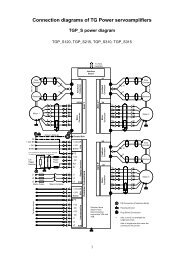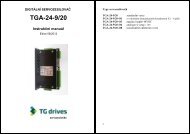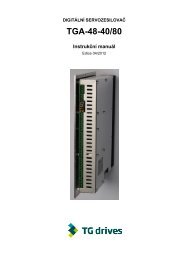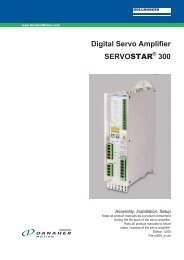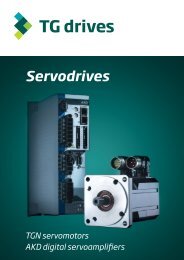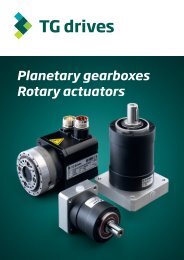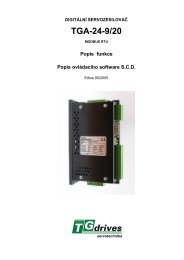Create successful ePaper yourself
Turn your PDF publications into a flip-book with our unique Google optimized e-Paper software.
Sales OfficeKIMEX s.r.o. KošiceTw<strong>in</strong>sp<strong>in</strong> Sales DepartmentPoštová 8040 01 KošiceSlovakiaPhone +421 95 / 622 17 30+421 95 / 623 13 75+421 95 / 623 13 76Fax +421 95 / 762 277+421 95 / 622 17 30E-mail tw<strong>in</strong>sp<strong>in</strong>@kimex.skWeb www.tw<strong>in</strong>sp<strong>in</strong>.skManufactur<strong>in</strong>g PlantEN I ISO 9001 900..Sp<strong>in</strong>ea s.r.o.Okrajová 33080 05 PrešovSlovakia— 2 —
<strong>Catalog</strong>ue Index1 TWINSPIN GENERAL INFORMATION 51.1 FEATURES AND BENEFITS 51.2 OPERATING PRINCIPLE 61.3 OVERVIEW OF THE REDUCER SERIES 71.4 AVAILABLE TYPES, RATIOS AND MODELS 71.5 ORDERING SPECIFICATIONS 81.6 FAQ’S 92 PERFORMANCE CHARACTERISTICS 102.1 RATING TABLE 102.2 PERFORMANCE AND SERVICE LIFE 122.2.1 EFFECTIVE INPUT SPEED (N EF) 122.2.2 MAXIMUM TORQUE DURING ACCELERATION AND BREAKING (T MAX) 122.2.3 MAXIMUM EMERGENCY TORQUE (T EM) 122.2.4 RATED SERVICE LIFE (L 10) 122.3 ROTARY DIRECTION AND REDUCTION RATIO 132.4 ALLOWABLE RADIAL-AXIAL LOAD AND TILTING MOMENT ON THE OUTPUT FLANGE 142.5 TILTING RIGIDITY AND DEFLECTION ANGLE OF THE OUTPUT FLANGE 152.6 TORSIONAL STIFFNESS, LOST MOTION AND BACKLASH 152.7 VIBRATIONS 172.8 ANGULAR TRANSMISSION ACCURACY 182.9 NO-LOAD STARTING TORQUE 192.10 BACK-DRIVING TORQUE 192.11 MAXIMUM TILTING MOMENT OF THE INPUT SHAFT (M CIN) 202.12 EFFICIENCY CHART 203 SELECTION PROCEDURE 213.1 WORKING CYCLE DIAGRAM 213.2 SELECTION FLOWCHART 223.3 SELECTION EXAMPLE 234 ASSEMBLY INSTRUCTIONS 254.1 EXAMPLES OF INSTALLATION 254.2 INSTALLATION PROCEDURE 274.3 ASSEMBLY TOLERANCES 284.4 ASSEMBLY PARTS’ TOLERANCES 294.5 SCREW TIGHTENING TORQUE AND ALLOWABLE TRANSMISSION TORQUE 334.6 LUBRICATION 334.7 GREASE INFORMATION 354.8 TEMPERATURE CONDITIONS 355 DRAWINGS 365.1 EXTERNAL DIMENSIONS T–MODEL 365.2 EXTERNAL DIMENSIONS SCX – MODEL 415.3 EXTERNAL DIMENSIONS SAX – MODEL 45— 3 —
5.4 APPLICATIONS 515.5 MOTOR FLANGES 516 GENERAL DELIVERY CONDITIONS 526.1 MAINTENANCE AND WARRANTY 526.2 DELIVERY CONDITIONS 526.3 PACKAGING, TRANSPORTATION AND STORAGE 526.4 WARRANTY 526.5 CLAIMS 526.6 FINAL STATEMENT 53— 4 —
1 Tw<strong>in</strong>sp<strong>in</strong> General InformationThe Tw<strong>in</strong>sp<strong>in</strong> (TS) bear<strong>in</strong>g reducers are high-precision reducers based on a new reduction mechanism anda new design of a radial-axial output bear<strong>in</strong>g. As a result, they represent a new generation of powertransmission systems. The notion “bear<strong>in</strong>g reducer” <strong>in</strong>dicates the full <strong>in</strong>tegration of a high-precision cycloidalreduction gear and a radial-axial bear<strong>in</strong>g <strong>in</strong> a s<strong>in</strong>gle unit.This new transmission concept allows the use of the TS reducers directly <strong>in</strong> robot jo<strong>in</strong>ts, rotary tables, andwheel gears <strong>in</strong> various transport systems.TS bear<strong>in</strong>g reducers are designed for applications requir<strong>in</strong>g a high reduction ratio, high k<strong>in</strong>ematicaccuracy, low lost motion, high moment capacity and high stiffness of a compact design with a limited<strong>in</strong>stallation zone, and low mass.1.1 Features and BenefitsBEARINGS• a unique design of output rollerbear<strong>in</strong>gs directly <strong>in</strong>tegrated <strong>in</strong> thecase• compared to tapered roller bear<strong>in</strong>gsthey make it possible to transferseveral times higher loads, by meansof an axial force• maximum support accuracy of the<strong>in</strong>put shaft and a pair of mutuallyconnected flanges relative to the caseOUTPUT SEALING• sealed output flange aga<strong>in</strong>st lubricantleakage• simple <strong>in</strong>stallation without anyadditional sealsNEEDLES – CYCLOIDAL GEARS• almost 50% needles mesh with acycloidal gear• high moment capacity• resistance aga<strong>in</strong>st moment shocks –up to 5 x nom<strong>in</strong>al torque• backlash-free operation, high stiffnessINPUT SHAFT• shaft hole design• possibility of direct connection to amotor by means of a keyway or a beltpulleyTRANSFORMATION MEMBER• preloaded seat<strong>in</strong>g• backlash-free operation• l<strong>in</strong>ear torsion characteristic• high stiffnessFig. 1: Description— 5 —
1.2 Operat<strong>in</strong>g Pr<strong>in</strong>cipleThe basic parts of TS bear<strong>in</strong>g reducers are shown <strong>in</strong> Fig.1 and Fig.2:CaseSeal<strong>in</strong>gFlangesInput shaftCycloidal gearsTransmission memberat the same time <strong>in</strong>corporates the high-capacity, precision radial-axial output bear<strong>in</strong>gs<strong>in</strong>tegrated <strong>in</strong> the reducer.on the output flange side, it prevents the reducer from <strong>in</strong>ternal contam<strong>in</strong>ation and/orlubricant leakage from the reducer.<strong>in</strong>put and output flanges are fixed together by fitted bolts, and rotate at reducedspeed <strong>in</strong> the radial-axial output bear<strong>in</strong>g relative to the case.high-speed member of the reduction mechanism carried by roller bear<strong>in</strong>gs <strong>in</strong> theflanges. Bear<strong>in</strong>g raceways are ground directly on the shaft and the flanges. The shafteccentrics rotationally support the cycloidal gears via roller bear<strong>in</strong>gs.their almost 50% simultaneously mesh<strong>in</strong>g trochoidal profile transmits a very hightorque which ensures powerful and backlash-free performance of the reducer.transforms the planetary motion of the cycloidal gears to the rotary motion of a pair offlanges.Fig. 2: Ma<strong>in</strong> parts of the Tw<strong>in</strong>sp<strong>in</strong>The operat<strong>in</strong>g pr<strong>in</strong>ciple is provided <strong>in</strong> Fig.1 and Fig.2. The shaft eccentrics, carried <strong>in</strong>roller bear<strong>in</strong>gs, cause roll<strong>in</strong>g of the cycloidal gears, which by means of the trochoidalprofile at the outer circumference mesh together with needle rollers placed <strong>in</strong> the casegrooves. Planetary motion of cycloidal gears is transformed <strong>in</strong>to rotary motion offlanges, through transmission members whose arms are roll-supported by the slots ofcycloidal gears and flanges. Flanges are fixed together by bolts and supported byradial-axial roller bear<strong>in</strong>gs <strong>in</strong>tegrated <strong>in</strong> a case. The reducer is mounted to the drivenequipment us<strong>in</strong>g the fix<strong>in</strong>g holes <strong>in</strong> the case or the output flange.— 6 —
1.3 Overview of the Reducer SeriesTab. 1: T and S series model selection accord<strong>in</strong>g to the load, <strong>in</strong>stallation, and operation characteristicsModelspecificationsLoad<strong>in</strong>gcharacteristicsInstallation andoperationcharacteristicsT – modelRobust design, <strong>in</strong>clud<strong>in</strong>g a double lip oilseal<strong>in</strong>g and a garter spr<strong>in</strong>g.Discont<strong>in</strong>uous operation cycle withrevers<strong>in</strong>g. Applicable also for cont<strong>in</strong>uousunidirectional operation on customer’srequest.Robust design.Lubrication with grease or oil possible.A wider range of modular configurations.See the T model draw<strong>in</strong>gs (Chaper 5).S – modelCompact design, <strong>in</strong>clud<strong>in</strong>g a built-<strong>in</strong> doublelip grease seal<strong>in</strong>g, without a garter spr<strong>in</strong>g.Discont<strong>in</strong>uous operation cycle withrevers<strong>in</strong>g. Cannot be used for cont<strong>in</strong>uousunidirectional operation.Compact design.Lubrication with grease only.A smaller range of modular configurations.See the S model draw<strong>in</strong>gs (Chapter 5).1.4 Available Types, Ratios and ModelsTab. 2: Tx – model availabilityT – seriesSize Model Available ratiosTS 70 TB 87TS 110 TA, TB 89, 135TS 140 TA, TB 33, 57, 87, 115, 175TS 170 TA, TB 33, 59, 83, 105, 141TS 200 TA, TB 63, 83, 125, 169Tab. 3: SCx – model availabilityS – seriesSize Model Available ratiosTS 60 SCA, SCB 35, 47, 73TS 80 SCA, SCB 37, 63, 97TS 140 SCA, SCB 33, 57, 87, 115, 175TS 170 SCA, SCB 33, 59, 83, 105, 141Tab. 4: SAx – model availabilitySize Model Available ratiosTS 60 SAA, SAB 35, 47, 73TS 80 SAA, SAB 37, 63, 97TS 140 SAA, SAB 33, 57, 87, 115, 175TS 170 SAA, SAB 33, 59, 83, 105, 141TS 240 SAA, SAB 59, 87, 121, 153TS 300 SAA, SAB 63, 95, 125, 191— 7 —
1.5 Order<strong>in</strong>g SpecificationsWhen order<strong>in</strong>g the reducer, use the follow<strong>in</strong>g product identification procedure:• T – series see draw<strong>in</strong>gs – Chapter 5TS 140 – 87 – T BModel of the fix<strong>in</strong>g holes <strong>in</strong> the caseABThrough holes <strong>in</strong> the caseThreaded holes <strong>in</strong> the caseT – seriesRatioSizeTw<strong>in</strong>sp<strong>in</strong>• S – series see draw<strong>in</strong>gs – Chapter 5TS 140 – 87 – S C BModel of the <strong>in</strong>put shaftA Input shaft without reliefBRelieved <strong>in</strong>put shaft on the side ofthe output flangeModel of the seal<strong>in</strong>gQuadr<strong>in</strong>g seal<strong>in</strong>g on the side of theAoutput flangeDouble lip oil seal<strong>in</strong>g on the side ofCthe output flangeS – seriesRatioSizeTw<strong>in</strong>sp<strong>in</strong>— 8 —
1.6 FAQ’s• Are reduction ratios between 20-30 possiblewith the Tw<strong>in</strong>sp<strong>in</strong> bear<strong>in</strong>g reducer?Transmission ratios between 20:1 and 30:1 areavailable on request. Consult the technical anddelivery conditions with the Tw<strong>in</strong>sp<strong>in</strong> SalesDepartment.• What is the noise of the Tw<strong>in</strong>sp<strong>in</strong> dur<strong>in</strong>g itsoperation?Tw<strong>in</strong>sp<strong>in</strong> runs extremely smoothly. Reference noisemeasurements of the reducer mounted on aservomotor are available on request.• Do you have <strong>in</strong>formation about thetemperature <strong>in</strong>crease, dur<strong>in</strong>g the cont<strong>in</strong>uousrunn<strong>in</strong>g of the Tw<strong>in</strong>sp<strong>in</strong> with rated load?Operation temperature is a lost motion dependentvalue and is limited by the <strong>in</strong>put effective speed.With the cont<strong>in</strong>uous runn<strong>in</strong>g of the Tw<strong>in</strong>sp<strong>in</strong> at<strong>in</strong>put effective speed and ambient temperature20° C, the operational temperature approaches aconstant value. If the average cycle speed exceedsthe <strong>in</strong>put effective speed, please consult theTw<strong>in</strong>sp<strong>in</strong> Sales Department.• Does the <strong>in</strong>put shaft have an axial play forcompensation of the heat growth from theconnected servomotor?There is an axial clearance at the <strong>in</strong>put shaft of thereducer that allows for the motor shaftprolongation due to operational temperature<strong>in</strong>crease. Please, handle properly the clearancewhen <strong>in</strong>terfac<strong>in</strong>g the reducer to a servomotor (seeChapter 4).• Why do you have the possibility of grease oroil lubrication?Grease is used for the standard applications. Oil isonly used for special application requests wherethere is demand for very low viscous friction, forhigh-speed applications, for special conditions andusers preferences (e.g. extremely cold environmentfor radar applications).• Is it possible to use the Tw<strong>in</strong>sp<strong>in</strong> reducer<strong>in</strong>dependent of the <strong>in</strong>stallation position? (B5,V1, V3)Yes. Installation position can be vertical orhorizontal. On request the manufacturer provideseng<strong>in</strong>eer<strong>in</strong>g support <strong>in</strong>clud<strong>in</strong>g assembly draw<strong>in</strong>gs.• What is meant by „service live“?Service life (L 10) means life expressed <strong>in</strong> hours with10% probability of failure.• What type of duty cycle determ<strong>in</strong>es the ratedtorque and the correspond<strong>in</strong>g service life?The type of duty cycle used is S1.• Do you provide <strong>in</strong>terface flanges and motorshaft connections for the different servomotors?Yes. We are able to provide you with thenecessary technical support. Regard<strong>in</strong>g the flange<strong>in</strong>terfac<strong>in</strong>g, we have a database of typical draw<strong>in</strong>gof connect<strong>in</strong>g coupl<strong>in</strong>g and <strong>in</strong>terface flanges. Weare able to prepare the assembly and detaildraw<strong>in</strong>gs for customers if they exactly specify thetype and size of motor. On request we are alsoable to manufacture the motor flange andcoupl<strong>in</strong>g.• The pair of flanges rotate with respect to thecase with reduced speed. Is there any radialaxialclearance on the output bear<strong>in</strong>g?There are two options. The first one is without anyclearance and preload <strong>in</strong> both directions as muchas necessary. Second assembly case there is anaxial and radial clearance up to 10 microns.• Why is Tw<strong>in</strong>sp<strong>in</strong> a zero backlash reducer?Tw<strong>in</strong>sp<strong>in</strong> is a zero backlash reducer becausebetween the rollers <strong>in</strong> the case and cycloidal gearsthere is no clearance. Every part of the reducer ismanufactured to a very high precision.• Is Tw<strong>in</strong>sp<strong>in</strong> self-lock<strong>in</strong>g?No. For back-driv<strong>in</strong>g torque values seeChapter 2.10.• Which part of the Tw<strong>in</strong>sp<strong>in</strong> do you use tocalculate the lifetime (i.e. which part of thereducer fails first)?The lifetime is calculated from the lifetime of thesupport<strong>in</strong>g roller bear<strong>in</strong>gs of the cycloidal gears.• Why is Tw<strong>in</strong>sp<strong>in</strong> called a bear<strong>in</strong>g reducer?Tw<strong>in</strong>sp<strong>in</strong> is called a bear<strong>in</strong>g reducer because <strong>in</strong>one unit of the Tw<strong>in</strong>sp<strong>in</strong> we have <strong>in</strong>tegrated a highprecision speed reducer and two radial-axial rollerbear<strong>in</strong>gs.— 9 —
2 Performance Characteristics2.1 Rat<strong>in</strong>g TableTab. 5: Rat<strong>in</strong>g tableSizeReduction ratioRated outputtorqueAcceleration andbrak<strong>in</strong>g torqueRated <strong>in</strong>put speedEffective cyclespeedMaximumallowable<strong>in</strong>put speedTilt<strong>in</strong>grigidityTorsionalstiffness 1)T RT maxN Rk ti [Nm] [Nm] [rpm] [rpm] [rpm] [Nm/arcm<strong>in</strong>] [Nm/arcm<strong>in</strong>]TS 60 35 4 000 3.7TS 60 47 37 74 2 000 3 00036 3.95 000TS 60 734.2TS 70 87 50 100 2 000 3 000 5 000 49 7.7TS 80 37 4 000 8.6TS 80 63 78 156 2 000 3 00062 9.35 000TS 80 979.5TS 110 89 23122 244 2 000 2 500 4 500 151TS 110 13524TS 140 33 3 000 512 000TS 140 574 000 54TS 140 87 268 670 2 000340 55TS 140 115 2 500 4 50056TS 140 17558TS 170 33 1 500 3 000 93TS 170 59 3 500 1012 000TS 170 83 495 1 238 2 000705 102TS 170 105 4 0001052 500TS 170 141106TS 200 63 1 500 3 500 161TS 200 83 166890 2 225 2 0001 070TS 200 125 2 000 4 000173TS 200 169184TS 240 59 1 200 2 500 309TS 240 87 3291 620 4 050 1 5001 640TS 240 121 1 500 3 000338TS 240 153345TS 300 63 1 000 2 500 640TS 300 95 6582 940 7 350 1 5003 320TS 300 125 1 300 3 000712TS 300 191720RIGHT TO CHANGE WITHOUT PRIOR NOTICE RESERVEDN efn maxM t1)2)3)4)Mean statistical value. For further <strong>in</strong>formation on torsional stiffness see Chapter 2.6.Load at output speed 15 [rpm]Tilt<strong>in</strong>g moment M c maxvalue for F a=0. If F a≠0, see Chapter 2.4.Axial force F a maxvalue for M c=0. If M c≠0, see Chapter 2.4.— 10 —
Tab. 5: cont<strong>in</strong>ueSizeReductionRatioMax. lost motionMax. tilt<strong>in</strong>gmoment 2)3)Max. radial force2)Max. axialforce 2)4)Input <strong>in</strong>ertiaI[10 -4 kgm 2 ]LM[arcm<strong>in</strong>]M c max[Nm]F r max[kN]F a max[kN] Sxx Tx TA TB SAx SCxTS 60 35TS 60 47 1 107 2.6 3.7 0.006 — — — 0.81 0.84TS 60 73TS 70 87 1 142 2.8 4.1 — 0.067 — 0.99 — —TS 80 37TS 80 63 1 280 4.8 6.9 0.027 — — — 1.58 1.58TS 80 97TS 110 89TS 110 1351 740 9.3 13.1 — 0.16 3.7 3.8 — —TS 140 33TS 140 57TS 140 87 1 1 160 11.5 17.0 0.488 0.676 6.3 6.4 5.8 6.3TS 140 115TS 140 175TS 170 33TS 170 59TS 170 83 1 2 430 19.3 27.9 0.777 1.156 11.2 11.4 10.9 11.3TS 170 105TS 170 141TS 200 63TS 200 83TS 200 1251 3 300 21.1 31.7 — 2.591 17.3 17.7 — —TS 200 169TS 240 59TS 240 87TS 240 1211 5 720 30.9 47.3 3.864 — — — 29.5 —TS 240 153TS 300 63TS 300 95TS 300 125TS 300 191Weightm[kg]1 12 000 45.4 68.1 11.180 — — — 53.3 —Important note: Load values <strong>in</strong> Tab. 5 are valid for rated service life L 10=6000 [Hrs]— 11 —
2.2 Performance and Service Life2.2.1 Effective Input Speed (N ef)Effective <strong>in</strong>put speed represents a limit for average work<strong>in</strong>g cycle speed. In the case higher speed isrequired, please contact the Tw<strong>in</strong>sp<strong>in</strong> Sales Department.2.2.2 Maximum Torque Dur<strong>in</strong>g Acceleration and Break<strong>in</strong>g (T max)Due to <strong>in</strong>ertial loads the torque applied dur<strong>in</strong>g acceleration and break<strong>in</strong>g is higher than the ratedvalue. The maximum allowable torque, when the reducer starts or stops is shown <strong>in</strong> Tab. 6.2.2.3 Maximum Emergency Torque (T em)Emergency stop and shock load may be accompanied by torque values higher than the nom<strong>in</strong>al value.The maximum permissible torque value is provided <strong>in</strong> Tab. 6. It should be noted that its occurrence is accidentaland rare, and <strong>in</strong> no way can it become a component part of a regular work<strong>in</strong>g cycle.Tab. 6: Permissible torque at acceleration, break<strong>in</strong>g and an emergency stopSizeMax torque dur<strong>in</strong>gacceleration and break<strong>in</strong>gT maxTS 60 – TS 110 2 × rated torque (T R)TS 140 – TS 300 2.5 × rated torque (T R)Permissible torqueat emergency stopT em5 × rated torque (T R)2.2.4 Rated Service Life (L 10)The Tw<strong>in</strong>sp<strong>in</strong> reducer’s service life is conditional on the service life of the roller bear<strong>in</strong>gs on the <strong>in</strong>put shafteccentrics. Tab. 7 gives service life values for all reducers <strong>in</strong> terms of the nom<strong>in</strong>al torque and the nom<strong>in</strong>al speed.Service life of the reducer is determ<strong>in</strong>ed by the life of the bear<strong>in</strong>g raceways on the <strong>in</strong>put shaft.Tab. 7: Rated service lifeL hService life (Hours)L 10L 10k 6000Service life for other speed and load values can be calculated as follows:kL hT aN aT RN Rrated lifetime [hrs]desired service life [hrs]average output torque [Nm]average <strong>in</strong>put speed [rpm]nom<strong>in</strong>al torque [Nm]nom<strong>in</strong>al <strong>in</strong>put speed [rpm]NL = k ×NRa⎛ TRT ⎟ ⎞×⎜⎝ a ⎠103— 12 —
2.3 Rotary Direction and Reduction RatioIn the follow<strong>in</strong>g equations, i outrepresents <strong>in</strong>put and output rotation <strong>in</strong> one direction, –i outrepresents <strong>in</strong>putand output rotation <strong>in</strong> the opposite direction. The reduction ratio (i) values are provided <strong>in</strong> Tab. 5.speediout=speed<strong>in</strong>putoutputTab. 8: Rotary direction and reduction ratioSpeedReductionInput: Input shaftOutput: Output flangeFixed: CaseInput: Input shaftOutput: CaseFixed: Output flangeInput: Output flangeOutput: CaseFixed: Input shafti out= - i i out= i+1i + 1i =iSpeedAccelerationInput: Output flangeOutput: Input shaftFixed: CaseInput: CaseOutput: Input shaftFixed: Output flangeInput: CaseOutput: Output flangeFixed: Input shaft1i = −i1i =i + 1ii =i + 1DifferentialconfigurationAll three parts can rotate— 13 —
2.4 Allowable Radial-Axial Load and Tilt<strong>in</strong>g Moment on the Output FlangeThe allowable radial load (F r) is provided <strong>in</strong> Tab. 5. The radial and axial load act <strong>in</strong>dependently due tothe output roller bear<strong>in</strong>gs. The tilt<strong>in</strong>g moment (Fig. 4) is expressed as follows:M c=F rx a + F ax bMcF rF atilt<strong>in</strong>g moment [Nm]radial load [N]axial load [N]a arm of action F r [m]b arm of action F a[m]The allowable load for the tilt<strong>in</strong>g moment (M c) and the axial force (F a) is given <strong>in</strong> Fig. 3., the po<strong>in</strong>t whosecoord<strong>in</strong>ates (M c, F a) lies <strong>in</strong> the area under the l<strong>in</strong>e of the selected reducer. For example, with TS 170Tand L 10=6000 [Hours], if the tilt<strong>in</strong>g moment is M c=1500 [Nm], then the axial force may be 10.7 [kN] max (seeFig. 3). The allowable radial and axial loads respectively, characterize the allowable dynamic load which canact on a reducer.Fig. 3: Relationship between the tilt<strong>in</strong>g moment and the axial force— 14 —
2.5 Tilt<strong>in</strong>g Rigidity and Deflection Angle of the Output FlangeThe Tw<strong>in</strong>sp<strong>in</strong> reducers can absorb external forces and moment loads due to the <strong>in</strong>tegrated output radialaxialbear<strong>in</strong>gs.When the output flange is loaded, the flange deflection angle is proportional to the respective tilt<strong>in</strong>gmoment. The moment rigidity (M t) is a tilt<strong>in</strong>g moment at which the output flange deflects by the angle θ =1’. TheM tvalues are given <strong>in</strong> the rat<strong>in</strong>g table (Table 5). The tilt<strong>in</strong>g angle (Θ) of the output flange (Fig. 4) can bedeterm<strong>in</strong>ed as follows:Fr× a + Fa× bΘ =MtΘM tF rF aaboutput flange tilt<strong>in</strong>g angle [arcm<strong>in</strong>]moment rigidity [Nm]radial load [N]axial load [N]arm of action F [m] ra = a1 + a2a1 = L / 2arm of action F a[m]Fig. 4: Load and the tilt<strong>in</strong>g moment on the output flange2.6 Torsional Stiffness, Lost Motion and BacklashIf the <strong>in</strong>put shaft and the case are locked aga<strong>in</strong>st rotation and a torque is applied to the output flange,then the load diagram has a shape of a hysteres is curve (Fig. 5).Fig. 5: Hysteresis curve and the def<strong>in</strong>ition of stiffnessLost motion (LM) is a pitch angle of the output flange at ±3% nom<strong>in</strong>al torque measured on the centerl<strong>in</strong>eof the hysteresis curve (Fig. 5).— 15 —
Torsional stiffness (k t) is def<strong>in</strong>ed as follows:dk t=cThe torsional stiffness and lost motion values are provided <strong>in</strong> Tab. 9.Tab. 9: Torsional stiffness and lost motionSizeReductionRatioRated torque Lost motion Torsional stiffnessT RMeasured torque LMi [Nm][Nm] [arcm<strong>in</strong>]TS 60 35 37 ± 1.1 1 3.7TS 60 47 37 ± 1.1 1 3.9TS 60 73 37 ± 1.1 1 4.2TS 70 87 50 ± 1.5 1 7.7TS 80 37 78 ± 2.3 1 8.6TS 80 63 78 ± 2.3 1 9.3TS 80 97 78 ± 2.3 1 9.5TS 110 89 122 ± 3.7 1 23TS 110 135 122 ± 3.7 1 24TS 140 33 268 ± 8.0 1 51TS 140 57 268 ± 8.0 1 54TS 140 87 268 ± 8.0 1 55TS 140 115 268 ± 8.0 1 56TS 140 175 268 ± 8.0 1 58TS 170 33 495 ± 14.8 1 93TS 170 59 495 ± 14.8 1 101TS 170 83 495 ± 14.8 1 102TS 170 105 495 ± 14.8 1 105TS 170 141 495 ± 14.8 1 106TS 200 63 890 ± 26.7 1 161TS 200 83 890 ± 26.7 1 166TS 200 125 890 ± 26.7 1 173TS 200 169 890 ± 26.7 1 184TS 240 59 1 620 ± 48.6 1 309TS 240 87 1 620 ± 48.6 1 329TS 240 121 1 620 ± 48.6 1 338TS 240 153 1 620 ± 48.6 1 345TS 300 63 2 940 ± 88.2 1 640TS 300 95 2 940 ± 88.2 1 658TS 300 125 2 940 ± 88.2 1 712TS 300 191 2 940 ± 88.2 1 720k t[Nm/arcm<strong>in</strong>]The torsional stiffness values provided <strong>in</strong> the Tab. 9 are statistical values for the particular reduction ratio.Bear<strong>in</strong>g reducers with hysteresis and lost motion of ≤0.6 [arcm<strong>in</strong>] can be supplied on request. Thehysteresis characteristic of TS 140-175-TB with the lost motion under 0.5 [arcm<strong>in</strong>] is illustrated <strong>in</strong> Fig. 6.— 16 —
Hysteresis600Lost motion0.384 arcm<strong>in</strong>400Stiffness k t2(50-100% T R)58 Nm/arcm<strong>in</strong>Torsional angle (arcsec)2000-600 -400 -200 0 200 400 600-200Stiffness k t3(100-200% T R)64.6 Nm/arcm<strong>in</strong>-400-600Load<strong>in</strong>g (Nm)Fig. 6: Hysteresis curve of TS 140-175-TB2.7 VibrationsVibration is a torsional vibration <strong>in</strong>dicated <strong>in</strong> a peripheral direction of an <strong>in</strong>ertia load driven by thereduction gear. Low vibration is extremely important for applications where high precision contour<strong>in</strong>g isrequired. For example, the tool center po<strong>in</strong>t of the end po<strong>in</strong>t of robot has to follow desired trajectory as close aspossible. If robot jo<strong>in</strong>ts vibrate, the trajectory track<strong>in</strong>g is poor. Additional axes of a mach<strong>in</strong>e tool is anotherapplication example when very high runn<strong>in</strong>g smoothness of a reducer is required.Accelerometer <strong>in</strong>stalled on a def<strong>in</strong>ed lever arm registers the vibration of an <strong>in</strong>ertia load. Referencemeasurement of peripheral acceleration and position deviation is shown <strong>in</strong> Fig. 7.Tw<strong>in</strong>sp<strong>in</strong> runs extremely smoothly. For <strong>in</strong>put speed higher than 500 rpm peripheral deviation is about 10micrometers.Tab. 10: Vibrations of TS 170-105-TBInput speed[rpm]% of 3000rpmLFD[µmpk]LFA[mmpk.s -2 ]45 1.5 23.15 3.6590 3 44.61 31.81180 6 30.75 9.1270 9 33.52 23.9360 12 41.31 53.92450 15 21.86 45.37540 18 11.35 34.31630 21 9.2 17.5720 24 12 42810 27 7.5 45900 30 7.5 42.5NotesLFD – amplitude (peak)LFA – acceleration (peak)Test conditionsModelTS 170-105-TBMeasured radius500 mm— 17 —
Vibrations100Amplitude (µm-peak, mm.s -2 )9080706050403020100– – – LFA [mmpk.s -2 ]———— LFD [µmpk]0 100 200 300 400 500 600 700 800 900 1000Input speed [rpm]2.8 Angular Transmission AccuracyFig. 7: Vibrations of the TS 170-105-TBAngular transmission error is the difference between a theoretical output angle of rotation and the actualangle of rotation. The angular transmission error for Tw<strong>in</strong>sp<strong>in</strong> bear<strong>in</strong>g reducers is 1 arcm<strong>in</strong> or less. Fig. 8 showsan example of the angular transmission error measured on a specific Tw<strong>in</strong>sp<strong>in</strong> reducer.25 arcsec.Measur<strong>in</strong>g conditionsModel: TS 140-175-TLoad conditions: no loadFig. 8: Angular transmission error measurement— 18 —
2.9 No-load Start<strong>in</strong>g TorqueThe no-load start<strong>in</strong>g torque is a quasi-static torque required to start rotation of the <strong>in</strong>put shaft, if no load isapplied to the output flange. Tab. 11 provides average values for start<strong>in</strong>g torque, statistically evaluated fromcurrent production tests.Tab. 11: Average start<strong>in</strong>g torqueModelRatioAverage no-loadstart<strong>in</strong>g torque[Nm]Tab. 12: Average back-driv<strong>in</strong>g torqueModelRatioAverage backdriv<strong>in</strong>g torque[Nm]TS 60 35 0.06 TS 60 35 2.0TS 60 47 0.05 TS 60 47 2.1TS 60 73 0.05 TS 60 73 2.9TS 70 87 0.08 TS 70 87 5.5TS 80 37 0.09 TS 80 37 3.9TS 80 63 0.08 TS 80 63 5.2TS 80 97 0.07 TS 80 97 6.2TS 110 89 0.3 TS 110 89 17TS 110 135 0.25 TS 110 135 18.1TS 140 33 0.37 TS 140 33 16.8TS 140 57 0.36 TS 140 57 20.1TS 140 87 0.29 TS 140 87 31.3TS 140 115 0.26 TS 140 115 39.4TS 140 175 0.19 TS 140 175 42TS 170 33 0.64 TS 170 33 23TS 170 59 0.45 TS 170 59 42TS 170 83 0.35 TS 170 83 49TS 170 105 0.34 TS 170 105 53TS 170 141 0.27 TS 170 141 56TS 200 63 0.44 TS 200 63 46TS 200 83 0.41 TS 200 83 51TS 200 125 0.3 TS 200 125 65TS 200 169 0.29 TS 200 169 105TS 240 59 1.24 TS 240 59 54TS 240 87 0.97 TS 240 87 74TS 240 121 0.93 TS 240 121 96TS 240 153 0.8 TS 240 153 121TS 300 63 1.9 TS 300 63 162TS 300 95 1.54 TS 300 95 168TS 300 125 1.5 TS 300 125 276TS 300 191 1.4 TS 300 191 4002.10 Back-driv<strong>in</strong>g TorqueMeasur<strong>in</strong>g conditionsAmbient temperature: 20° CLubricant: greaseBack-driv<strong>in</strong>g torque is the torque applied on the output flange, that is required to start rotation of the<strong>in</strong>put shaft left under no load.— 19 —
2.11 Maximum Tilt<strong>in</strong>g Moment of the Input Shaft (M c<strong>in</strong>)S<strong>in</strong>ce the <strong>in</strong>put shaft is supported on both sides by roller bear<strong>in</strong>gs, radial loads may be applied to the<strong>in</strong>put shaft. The tilt<strong>in</strong>g moment on the <strong>in</strong>put shaft, result<strong>in</strong>g from radial load (Fig. 9), can be calculated asfollows:M c<strong>in</strong>= F r<strong>in</strong>x aAllowable tilt<strong>in</strong>g moment M c<strong>in</strong>on the <strong>in</strong>put shaft are provided <strong>in</strong> Tab. 13.Tab. 13: Allowable tilt<strong>in</strong>g moment M c<strong>in</strong>on the <strong>in</strong>put shaftSizeM c<strong>in</strong>TS 60 6TS 70 10TS 80 16TS 110 35TS 140 68TS 170 126TS 200 157TS 240 260TS 300 378Fig. 9: Radial load of the <strong>in</strong>put shaft2.12 Efficiency ChartThe efficiency of the Tw<strong>in</strong>sp<strong>in</strong> bear<strong>in</strong>g reducer depends on the <strong>in</strong>put speed, the grease temperature, andthe Tw<strong>in</strong>sp<strong>in</strong> size. Fig. 10 shows the efficiency curves for the TS 200-63-TB bear<strong>in</strong>g reducer.Measur<strong>in</strong>g conditionsAmbient temperature: 20° CLubricant: greaseFig. 10: TS 200-63-T efficiency chart— 20 —
3 Selection Procedure3.1 Work<strong>in</strong>g Cycle DiagramT 1T 2T 3T maxmaximum output torque at acceleration [Nm]output torque at constant speed [Nm]maximum output torque at deceleration [Nm]max. output torque at emergency stop [Nm]N 1N 2N 3N maxaverage <strong>in</strong>put speed at acceleration [rpm]<strong>in</strong>put speed at constant motion [rpm]average <strong>in</strong>put speed at deceleration [rpm]maximum <strong>in</strong>put speed [rpm]t 1acceleration time[s -1 ]t 2constant motion time [s -1 ]t 3deceleration time [s -1 ]t 4idle time [s -1 ]t work<strong>in</strong>g cycle time [s -1 ]F rF aabiradial output flange load [N]axial output flange load [N]radial load effects arm F r[m]axial load effects arm F [m] areduction ratioIn case the work<strong>in</strong>g cycle is different from the one shown,please supply the draw<strong>in</strong>g and values of your work<strong>in</strong>g cycle.These values are important, so that we can effectively determ<strong>in</strong>ethe lifetime of the TS bear<strong>in</strong>g reducer.Fig. 11: Work<strong>in</strong>g cycle— 21 —
3.2 Selection FlowchartFig. 121. Calculation of theaverage output torque (T a)2. Calculation of theaverage <strong>in</strong>put speed (N a)3. Prelim<strong>in</strong>ary reducer selectionfrom the rat<strong>in</strong>g table4. Service Lifecalculation (L h)1010⎛⎜ 33t1N 1T1+ t2N2T2+ ... + tnNnTTa= ⎜⎜ t1N1+ t2N2+ ... + tnNn⎝t1N1+ t2N2+ ... + tnNnNa=t + t + ... + t12103N ⎛RT ⎞RLh= k × ×N⎜aT ⎟ ⎝ a ⎠n103n⎞⎟⎟⎟⎠0.3Correction of the reducer sizeor reduction of its loadT Rnom<strong>in</strong>al output torqueN Rnom<strong>in</strong>al <strong>in</strong>put speedk nom<strong>in</strong>al service life (6000 Hrs.)L h≥desiredservice life (Hrs.)No5. Effectivespeed checkN a≤N efNo6. Inputspeed check7. Acceleration andbreak<strong>in</strong>g torque checkT 1,T 3≤ 2xT RorT 1,T 3≤ 2.5xT RSee Chapter2.2.3N 2≤N maxNo8. Emergency torquecheckNoT em≤5xT RNoMa<strong>in</strong> roller bear<strong>in</strong>gcapacity check9. Output flange deflectionangle (Θ) check(Θ)≤desiredangleFr× a + Fa× bΘ =MtNo10. External loadcheckF r≤F rmaxNoSee Chapter 2.4No(M c, F a) lies <strong>in</strong>the range forreducerM c= F r×a + F a×bF<strong>in</strong>al reducerselection— 22 —
3.3 Selection Example• Input data – Selection conditionsAcceleration torqueConstant torqueBreak<strong>in</strong>g torqueEmergency torqueAvg. accel. <strong>in</strong>put speedConstant <strong>in</strong>put speedAvg. break<strong>in</strong>g <strong>in</strong>put speedRadial loadAxial loadRadial force tilt<strong>in</strong>g armAxial force tilt<strong>in</strong>g armMax. allowable output flange deflection angleAcceleration timeConstant speed timeBreak<strong>in</strong>g timeT 1=420 NmT 2=310 NmT 3=520 NmT em=1500 NmN 1=1500 rpmN 2=3000 rpmN 3=1500 rpmF r=1500 NF a=1500 Na 2=0.15mb=0.2mΘ max=3 arcm<strong>in</strong>.t 1=0.3sec.t 2=0.5sec.t 3=0.2sec.• Calculation example1. Calculation of average output torque (T a)1010⎛330.3 1500 420 0.5 3000 310 0.2 1500 520T ⎜ × × + × × + × ×a =⎜ 0.3×1500+0.5×3000+0.2×1500⎝2. Calculation of average <strong>in</strong>put speed (N a)0.3×1500+0.5×3000+0.2×1500=0.3+0.5+0.2Na =103⎞⎟⎟⎠2250rpm3. Prelim<strong>in</strong>ary reducer selection from the rat<strong>in</strong>g table (Tab. 5): TS170–141–TATechnical specifications of the reducer selected:0,3= 379.6NmRated torqueRated <strong>in</strong>put speedMax. torqueEmergency torqueEffective <strong>in</strong>put speedMax. <strong>in</strong>put speedTilt<strong>in</strong>g rigidityMax. tilt<strong>in</strong>g moment (Fa=0)Radial forceMax. axial force (Mc=0)T R= 495 NmN R= 2 000 rpmT max= 1 238 NmT em= 2 475 NmNef = 2 500 rpmN max= 4 000 rpmM t= 705 Nm/arcm<strong>in</strong>.M cmax= 2 430 NmF r max= 19 300 NF a max= 27 900 N4. Service life calculation (L h)103h =2000 ⎛ 495 ⎞L = 6000×× ⎜ ⎟2250 ⎝ 379.6 ⎠12919Hrs.— 23 —
5. Effective speed check (N a, N ef)6. Input speed check (N 2, N max)(N a= 2 250) < (2 500 = N ef) OK(N 2= 3000 rpm) < (N max= 4000 rpm) OK7. Accelerat<strong>in</strong>g and brak<strong>in</strong>g torque check (T 1, T 3,T max)8. Emergency brak<strong>in</strong>g torque check (T em)9. Output flange tilt<strong>in</strong>g angle check (Θ)(T 1= 420Nm) < (T max= 1 238Nm) OK(T 3= 520Nm) < (T max= 1 238Nm) OK(T em= 1500 Nm) < 2475 Nm OK1500x0.1885 + 1500x0.2 582.75( Θ =0 0 49 ) (max3')705= 705= ° ′ ′′ < Θ =OK10. External load check (F r, M c)Tilt<strong>in</strong>g arm(see fig. 4)a = a1 + a2;a1 = 0.0385 mL / 2 = 77 mm / 2 = 38.5 mm = 0,0385 ma= 0.0385 + 0.15 = 0.1885 m(F r= 1500 N) < (F rmax=19 300 N) OKTilt<strong>in</strong>g moment on the output flangeM c= 1500 x 0.1885 + 1500 x 0.2 = 582.75 NmMaximum allowable tit<strong>in</strong>g moment at axial force Fa = 1500 NMcmax× Fa2430×1500Mc allow.= Mc max− = 2430−= 2300NmF27900amax(M c= 582.75) < (M c allow= 2300 Nm) OKBased on Chapter 2.4, a po<strong>in</strong>t with the coord<strong>in</strong>ates of (M c, F a), i.e. (582.75 Nm; 1.5 kN),lies <strong>in</strong>side the range for the selected TS 170 reducer.S<strong>in</strong>ce all the requirements have been met, selection of the TS 170-141-TA (/TB) reducer is correct.For easier selection of the Tw<strong>in</strong>sp<strong>in</strong> bear<strong>in</strong>g reducer, you can request theTw<strong>in</strong>sp<strong>in</strong> Selection Assistant selection softwareor you can directly download it from our Internet web page www.tw<strong>in</strong>sp<strong>in</strong>.sk.— 24 —
4 Assembly InstructionsTo get the maximum performance from Tw<strong>in</strong>sp<strong>in</strong> bear<strong>in</strong>g reducer, it is important to pay attention to the<strong>in</strong>stallation, assembly accuracy, seal<strong>in</strong>g and lubrication.4.1 Examples of InstallationThe most frequent connection types between the Tw<strong>in</strong>sp<strong>in</strong> bear<strong>in</strong>g reducers and servo-motors.• Description of T – model <strong>in</strong>stallations:a. Direct connection with a motor, sealed motor shaft, same motor shaft diameter and reducer shaftdiameter.b. Direct connection with a motor, non-sealed motor shaft, same motor shaft diameter and reducer shaftdiameter.c. Connection with a motor through keyway-keyway reduction shaft, motor shaft diameter bigger thenreducer shaft diameter, non-sealed motor shaft.d. Connection with a motor through clamp-keyway reduction shaft, motor shaft diameter bigger thenreducer shaft diameter, non-sealed motor shaft.e. Connection with a motor through flexible wave coupl<strong>in</strong>g, motor shaft diameter bigger then reducershaft diameter, non-sealed motor shaft.f. Example of a p<strong>in</strong>ion driven reducer.• Description of S – model <strong>in</strong>stallations:g. Direct connection with a motor, sealed motor shaft, same motor shaft diameter and reducer shaftdiameter.h. Example of a p<strong>in</strong>ion driven reducer.Fig. 13 provides examples of possible reducer variations, connections and seal<strong>in</strong>g methods. In case ofdirect connection (case a, b, c, d, g) of the reducer to the motor shaft, tolerances must be observed <strong>in</strong> order toavoid uncontrolled bend<strong>in</strong>g stress of the motor shaft and excessive bear<strong>in</strong>g load. The tolerance values arespecified <strong>in</strong> the Tab. 15.When <strong>in</strong>stall<strong>in</strong>g the reducer, observe the dimensional tolerances of mount<strong>in</strong>g diameters and prevent thereducer from contam<strong>in</strong>ation and/or lubricant leakage. For this purpose, see Fig. 14 and Fig. 13.Motors that fulfill the standard flange and keyway tolerances as specified <strong>in</strong> the European Standard DIN42955 are acceptable for standard applications. To take the full advantage of the performance and lifetimecharacteristics of the Tw<strong>in</strong>sp<strong>in</strong> and for high precision application the manufacturer recommends to choosemotors that fulfill the European Standard DIN 42955 R. The Tw<strong>in</strong>sp<strong>in</strong> Sales Department will be pleased toprovide you with further <strong>in</strong>formation about these standards or to provide you with technical assistance for yourspecific application.— 25 —
• T - series- a - - b –- c - - d -- e - - f –• S - series- g - - h -Fig.13: Most frequent connections— 26 —
4.2 Installation ProcedurePrior to <strong>in</strong>stallation, wipe off the conservation oil layer from the reducer’s surface with a clean and drycloth. If the surface is dirty, use a cloth soaked <strong>in</strong> a suitable solvent (C6000 th<strong>in</strong>ner, <strong>in</strong>dustrial petrol). It isimportant to prevent the th<strong>in</strong>ner from penetrat<strong>in</strong>g <strong>in</strong>to the reducer. Degrease the contact surfaces of friction-typeconnections.• T – series1. Tw<strong>in</strong>sp<strong>in</strong>2. Output3. Screws4. O-r<strong>in</strong>g5. Shaft seal<strong>in</strong>g6. Motor flange7. Servomotor8. Frame• S – series1. Tw<strong>in</strong>sp<strong>in</strong>2. O-r<strong>in</strong>g3. Output4. Screws5. O-r<strong>in</strong>g6. Motor flange7. Frame8. Seal<strong>in</strong>g9. ServomotorFig.14: Installation procedure— 27 —
4.3 Assembly TolerancesRequirements on circumferential and front run-out with the connection of a servomotor to the bear<strong>in</strong>greducer by means of a keyway, T and S models are shown <strong>in</strong> Tab. 14 and 15.Tab. 14: T – model assembly tolerances (refer to Fig. 15)Size a b c D ATS 70 0.018 0.04 0.038 11 k6 59.3 g6TS 110 0.018 0.05 0.044 14 k6 93 g6TS 140 0.021 0.05 0.05 19 k6 119 g6TS 170 0.021 0.05 0.05 24 k6 145 g6TS 200 0.021 0.06 0.058 24 k6 170 g6Tab. 15: S – model assembly tolerances (refer to Fig. 15)Size a b c D ATS 60 0.015 0.04 0.038 6 k6 63 H7TS 80 0.015 0.05 0.038 8 k6 80 H7TS 140 0.021 0.05 0.05 19 k6 140 H7TS 170 0.021 0.05 0.05 19 k6 170 H7TS 240 0.021 0.063 0.058 28 k6 240 H7TS 300 0.021 0.063 0.064 28 k6 300 H7Fig.15: Assembly tolerancesTab. 16: T – model circumferential and front run-out values (refer to Fig. 16)Size T ZStandardR— 28 —On requestA C DTS 70 0.003 0.007 0.015 0.005 70 h7 26 H6 11 H7TS 110 0.004 0.008 0.015 0.005 110 h7 32 H6 14 H7TS 140 0.008 0.010 0.015 0.005 140 h7 42 H6 19 H7TS 170 0.008 0.010 0.015 0.005 170 h7 47 H6 24 H7TS 200 0.010 0.014 0.02 0.008 200 h7 52 H6 24 H7
Tab. 17: S – model circumferential and front run-out values (refer to Fig. 16)Size T ZStandardROn requestA C DTS 60 0.003 0.007 0.015 0.005 63 h7 15.5 H6 6 H7TS 80 0.003 0.007 0.015 0.005 80 h7 22.3 H6 8 H7TS 140 0.008 0.010 0.015 0.005 140 h7 40 H6 19 H7TS 170 0.008 0.010 0.015 0.005 170 h7 43.5 H6 19 H7TS 240 0.010 0.016 0.02 0.008 240 h7 57 H6 28 H7TS 300 0.010 0.016 0.02 0.01 300 h7 60 H6 28 H74.4 Assembly Parts’ TolerancesFig.16: Circumferential and front run-out valuesTab. 18: Dimension table for <strong>in</strong>put and output flanges of Tw<strong>in</strong>sp<strong>in</strong> bear<strong>in</strong>g reducer model TA, TB [mm] (Fig. 17)Size ∅A g6 ∅B h9 ∅C +0,1 ∅D ∅E ∅F H8 ∅G ∅H ∅J j6 ∅K +0,2 ∅LTS 70 59.3 57.9 57.9 31 24 26 64 22 26 — 42TS 110 93 90 90 36 29 32 100 24 32 33 69TS 140 119 116 112 48 39 42 127 34 42 43 92TS 170 145 142 138 54 44 47 156 39 47 48 110TS 200 170 167 167 62 48 52 183 43 52 53 131Size ∅N ∅P H7 ∅R ∅S ∅T A1 A2 A3 B1 B2 B3TS 70 4.3 70 58 64 3.2 R2 R 0.8 - 0.3x45° 0.3x45° 0.3x45°TS 110 6.4 110 88 100 5.3 R 0.8 R 0.8 R 0.2 0.3x45° 0.5x45° 0.5x45°TS 140 6.4 140 115 127 6.4 R 0.8 R 0.8 R 0.2 0.5x45° 0.5x45° 0.5x45°TS 170 8.4 170 140 156 8.4 R 0.8 R 0.8 R 0.3 0.5x45° 0.5x45° 0.5x45°TS 200 10.5 200 165 183 10.5 R 0.8 R 0.8 R 0.3 0.5x45° 0.5x45° 0.5x45°Size C1 +0,2 C2 C3 ∅E1 H12 E2 E3 F2 F3 G1 -0,1 G2 G3 +0,05TS 70 1.4 0.7 5 3.2 1 5 3 R 0,5 2.8 4.3 —TS 110 2 1.5 5 5.3 1.5 5 4.5 R 0,5 3.5 6 0.7TS 140 2 1.5 5 6.4 1.5 5 2 R 0,5 3.5 6 0.7TS 170 2 2 5 8.4 1.5 5 3.5 R 0,5 3.5 7 1.1TS 200 2.5 2 5 10.5 1.5 5 5.5 R 0,8 5.5 7.5 1.1— 29 —
Tab. 18: cont<strong>in</strong>ueSize G4 G5 H1 M +0,2 V O-R<strong>in</strong>g ATS 70 7.8 2.8 5.8 – R 0.5 55x1 eg. Viton-FPM70 DichtomaticTS 110 9 1.5 6 1.4 R 0.5 89x2 eg. ARP Busak+ShambanTS 140 9 1.5 3.5 1.4 R 0.5 115x2 eg. Viton-FPM70 DichtomaticTS 170 9 0 3.5 2.1 R 0.5 140x2 eg. Viton-FPM70 DichtomaticTS 200 12 2.5 8 2.1 R 0.5 165x2 eg. Viton-FPM70 DichtomaticSize O-R<strong>in</strong>g B Double Lips Oil Seal<strong>in</strong>gTS 70 22x2 eg. Viton-FPM70 Dichtomatic KACO DE 20x26x4TS 110 34x1 eg. Busak+Shamban 22x32x6 eg. SIMRIT BABSL-FKMTS 140 44x1 eg. Busak+Shamban 30x42x6 eg. SIMRIT BABSL-FKMTS 170 49x1,5 eg. Busak+Shamban 35x47x7 eg. Busak+Shamban TREA 00350TS 200 54x1,5 eg. Busak+Shamban 38x52x7 eg. SIMRIT BAUMSLX7 FKM 585Tab. 19: Dimension table for <strong>in</strong>put and output flanges of Tw<strong>in</strong>sp<strong>in</strong> bear<strong>in</strong>g reducer model SAx, SCx [mm] (Fig. 18)Size ∅B1 ∅B2 ∅E1 ∅G ∅H1 ∅K1 +0.2 ∅J1 j6 ∅N ∅P H7 ∅RTS 60 49.2 69 3.2 57 12 17.2 15.5 4.3 63 51TS 80 64.6 86 4.3 73 17 24.8 22.3 5.3 80 65TS 140 115.15 148 6.4 127 32 46.9 40 6.4 140 115TS 170 141.35 178 8.4 156 32 56.4 43.5 8.4 170 141TS 240 201.05 250 13 220 47 81.4 57 13 240 201TS 300 249.6 312 17 274 50 105.4 60 17 300 248Size T A5 A6 B6 C6 E6 F6 H5 +0.05 M 1+0.2TS 60 ∅3.2 R 0.3 R 0.2 0.5x45° 4 3 R 0.5 1.1 1.4 2.1TS 80 ∅4.3 R 0.3 R0.3 0.5x45° 5 4 R 0.5 1.1 2.1 2.1TS 140 M6 R0.4 R0.4 0.5x45° 6 5 R 0.5 1.3 2.8 2.6TS 170 M8 R0.4 R0.4 0.5x45° 6 5 R 0.5 1.5 2.8 2.8TS 240 M12 R0.4 R0.4 0.5x45° 7 6 R 0.5 1.5 2.8 2.8TS 300 M16 R0.4 R0.4 0.5x45° 7 6 R 0.5 1.5 2.8 2.8S5 +0.2Size S6 V O-R<strong>in</strong>g A. eg. Busak+Shamban O-R<strong>in</strong>g B. eg. Busak+ShambanTS 60 0.7 R 0.5 50x1.5 18x1TS 80 1.1 R 0.5 65x1.5 26x1.5TS 140 1.5 R 0.5 117.1x1.78 48x2TS 170 1.5 R 0.5 143x2 58x2TS 240 1.5 R 0.5 205x2 84x2TS 300 1.5 R 0.5 255x2 106x2— 30 —
Fig.17: Dimensions for <strong>in</strong>put and output flanges of Tw<strong>in</strong>sp<strong>in</strong> bear<strong>in</strong>g reducer type TA, TB— 31 —
Fig.18: Dimensions for <strong>in</strong>put and output flanges of Tw<strong>in</strong>sp<strong>in</strong> bear<strong>in</strong>g reducer model SAx, SCx— 32 —
4.5 Screw Tighten<strong>in</strong>g Torque and Allowable Transmission TorqueTo ensure reliable transmission of the external reducer load, use the ISO 898 T1-10.9 or 12.9 materialclass of connect<strong>in</strong>g screws and degrease the contact surfaces of the friction-type connections. Tab. 14 providestighten<strong>in</strong>g moments for the screws.Tab. 20 provides the permissible torque transmitted by connect<strong>in</strong>g screws on the output flange and thecase.Tab.20 Screw tighten<strong>in</strong>g momentsScrew sizeTighten<strong>in</strong>g moment Clamp<strong>in</strong>g force[Nm][N]M3 1.9 3 100M4 4.3 5 300M5 8.4 8 800M6 14 12 400M8 35 22 750M10 70 36 200M12 122 52 900M16 300 100 000Tab.21 Permissible torques transmitted by connect<strong>in</strong>g screwsScrew material classspecificationISO 898 T110.9or12.9Size -ModelNumber xscrewThrough the output flangePCD[mm]Transferredtorque [Nm]Number xscrewThrough the casePCD[mm]Transferredtorque [Nm]TS 60 – Sxx 8xM4 34 108 12xM3 57 160TS 70 – Tx 14xM4 42 233 16xM3 64 238TS 80 – Sxx 8xM5 46 242 12xM4 73 348TS 110– Tx 14xM6 69 898 12xM5 100 792TS 140– Tx14xM68xM692741 740 12xM6 127 1 410TS 140 – Sxx 14xM6 92 1 190 12xM6 127 1 410TS 170 – Tx14xM88xM8110803 700 12xM8 156 3 200TS 170 – Sxx 14xM8 110 2 620 12xM8 156 3 200TS 200 – Tx14xM108xM10131956 950 12xM10 183 5 900TS 240 – Sxx 14xM12 160 8 400 12xM12 220 9 900TS 300 – Sxx 14xM16 200 19 950 12xM16 274 23 4204.6 LubricationThe Tw<strong>in</strong>sp<strong>in</strong> bear<strong>in</strong>g reducer is standardly lubricated with the Optimol LONGTIME PD 0 grease.Alternatively, the Optimol OPTIGEAR 150 oil may be used.The lubricant exchange <strong>in</strong>terval <strong>in</strong> operation is every 20 000 hours. Should the lubricant becontam<strong>in</strong>ated or otherwise impaired dur<strong>in</strong>g the reducer’s operation, exchange the lubricant immediately.The first lubricant fill<strong>in</strong>g (prelim<strong>in</strong>ary fill<strong>in</strong>g) is performed at the manufactur<strong>in</strong>g plant. Grease and oilquantities for the <strong>in</strong>dividual reducers are specified <strong>in</strong> Tab. 22. These quantities, however, do not <strong>in</strong>clude the— 33 —
space between the reducer and the connected parts. If no shaft seal<strong>in</strong>g is used here, the user must fill it with thelubricant (see Fig. 13 a, g).Reducers are lubricated through the lubrication holes <strong>in</strong> the case at simultaneous slow output speed.Tab. 22: Recommended lubricant quantities [cm 3 ]Input shaft axis positionSizeVerticalHorizontal with the flangesfixed to the baseHorizontal with the case fixedto the baseT - model S - model T - model S - model T - model S - modelTS 60 — 7 — 7 — 5TS 70 13 — 13 — 10 —TS 80 — 19 — 19 — 15TS 110 40 — 40 — 32 —TS 140 89 80 89 80 74 65TS 170 154 130 154 130 129 105TS 200 227 — 227 — 187 —TS 240 — 380 — 380 — 300TS 300 — 590 — 590 — 470Lubricant level <strong>in</strong> horizontal position, whenthe flanges are connected to a base.Lubricant level <strong>in</strong> horizontal positionif the case is fixed to a base.Lubricant level <strong>in</strong> vertical positionFill the space between the reducer and motorwith a lubricant dur<strong>in</strong>g the <strong>in</strong>stalation process.Fig.19: Grease levels <strong>in</strong> horizontal and vertical positions— 34 —
4.7 Grease InformationOptimol Longtime PD 0 & 00 DescriptionOptimol Longtime PD 0 & 00 are special half liquid greases on the basis of m<strong>in</strong>eral oil conta<strong>in</strong><strong>in</strong>g 12-hydroxystereat Li and by load<strong>in</strong>g activated aditive technology Optimol Microflux Trans. It is suitable even forcentral lubricat<strong>in</strong>g systems, which were <strong>in</strong>itially made for oil, or also as fill<strong>in</strong>gs for gearboxes (e.g. not tight).Usage• for restrictions of wear<strong>in</strong>ess, damages fromusage, abrasion and material exhaustion (bypitt<strong>in</strong>g) on abrasive surfaces also dur<strong>in</strong>ga runn<strong>in</strong>g <strong>in</strong>• for extremely high pressures• for roller bear<strong>in</strong>gs with grease cartridgesAdvantages• reduction of runn<strong>in</strong>g <strong>in</strong> period and improvementof characteristics of abrasive surfaces, notpossible to achieve by familiar lubricant• exceptional capacity of load<strong>in</strong>g, cut-down ofabrasive ratio with possibility of energy sav<strong>in</strong>g• optimum protection aga<strong>in</strong>st wear<strong>in</strong>ess and aneffect of smooth<strong>in</strong>g of previously formed pitt<strong>in</strong>gs• exceptional protection aga<strong>in</strong>st corrosion andtribocorrosionInstructions• for lubrication by half liquid grease under thehardest work<strong>in</strong>g conditions, i.e. screw and flangegear boxes, ragged clutches, not tight gearboxes etc.• for central lubrication i.e. pr<strong>in</strong>t<strong>in</strong>g and pack<strong>in</strong>gmach<strong>in</strong>es• easily ga<strong>in</strong>ed <strong>in</strong> central systems and compatiblewith any familiar seal<strong>in</strong>g materials and colouredmetals• cold and hot water resistant• noise and work<strong>in</strong>g temperatures cut down• smooth runn<strong>in</strong>g without slot form<strong>in</strong>g <strong>in</strong> gearboxes dur<strong>in</strong>g high operat<strong>in</strong>g speed• temperature range of application –35°C to+140°CFill the gear box up to the mark for grease fill<strong>in</strong>g or maximum to its half. Follow the manufacturer’srecommendations. The lubricant has its maximum effectiveness only if not mixed with another lubricant.Tab. 23: Lubricant characteristicsTypical data Value PD 0 PD 00 Exam<strong>in</strong>ed byColor — brown—red brown—red —Character — Li grease Li grease —Po<strong>in</strong>t of condesity°C°F> +170> +338> +160> +320DIN ISO 2176Penetration 0.1 mm 355—385 400—430 DIN ISO 2137Water volume m — % < 0.1 < 0.1 DIN 51 777Water resistance at+ 90°C/ + 194 °F—0(without changes)0(without changes)DIN 51807Part 1SKF Emcor — 0/0 0/0 DIN 51 802Roller useAbrasion coefficientmmm (m<strong>in</strong>)m (max)0.830.0570.1230.850.0570.110Depth of wear<strong>in</strong>ess m m 0.6 0.3Viscosity 100 at 40°CThis technical data are average result rates. Small variants of these rates may occur from case to case.Other <strong>in</strong>formation is available on request.———4.8 Temperature ConditionsThe Tw<strong>in</strong>sp<strong>in</strong> bear<strong>in</strong>g reducers are designed for the ambient temperature range of -10 to +40 °C.Applications for other temperature conditions should be consulted with the Tw<strong>in</strong>sp<strong>in</strong> Sales Department <strong>in</strong>advance.— 35 —
5 Draw<strong>in</strong>gs5.1 External Dimensions T–modelTw<strong>in</strong>sp<strong>in</strong> TS70 - i - TBFig. 20: Tw<strong>in</strong>sp<strong>in</strong> TS70 model TB— 36 —
Tw<strong>in</strong>sp<strong>in</strong> TS110 - i - TA/TBFig. 21: Tw<strong>in</strong>sp<strong>in</strong> TS110 model TA/TB— 37 —
Tw<strong>in</strong>sp<strong>in</strong> TS140 - i - TA/TBFig. 22: Tw<strong>in</strong>sp<strong>in</strong> TS140 model TA/TB— 38 —
Tw<strong>in</strong>sp<strong>in</strong> TS170 - i - TA/TBFig. 23: Tw<strong>in</strong>sp<strong>in</strong> TS170 model TA/TB— 39 —
Tw<strong>in</strong>sp<strong>in</strong> TS200 - i - TA/TBFig. 24: Tw<strong>in</strong>sp<strong>in</strong> TS200 model TA/TB— 40 —
5.2 External Dimensions SCx – modelTw<strong>in</strong>sp<strong>in</strong> TS60 - i - SCA/SCBFig. 25: Tw<strong>in</strong>sp<strong>in</strong> TS60 model SCA/SCB— 41 —
Tw<strong>in</strong>sp<strong>in</strong> TS80 - i - SCA/SCBFig. 26: Tw<strong>in</strong>sp<strong>in</strong> TS80 model SCA/SCB— 42 —
Tw<strong>in</strong>sp<strong>in</strong> TS140 - i - SCA/SCBFig. 27: Tw<strong>in</strong>sp<strong>in</strong> TS140 model SCA/SCB— 43 —
Tw<strong>in</strong>sp<strong>in</strong> TS170 - i - SCA/SCBFig. 28: Tw<strong>in</strong>sp<strong>in</strong> TS170 model SCA/SCB— 44 —
5.3 External Dimensions SAx – modelTw<strong>in</strong>sp<strong>in</strong> TS60 - i - SAA/SABFig. 29: Tw<strong>in</strong>sp<strong>in</strong> TS60 model SAA/SAB— 45 —
Tw<strong>in</strong>sp<strong>in</strong> TS80 - i - SAA/SABFig. 30: Tw<strong>in</strong>sp<strong>in</strong> TS80 model SAA/SAB— 46 —
Tw<strong>in</strong>sp<strong>in</strong> TS140 - i - SAA/SABFig. 31: Tw<strong>in</strong>sp<strong>in</strong> TS140 model SAA/SAB— 47 —
Tw<strong>in</strong>sp<strong>in</strong> TS170 - i - SAA/SABFig. 32: Tw<strong>in</strong>sp<strong>in</strong> TS170 model SAA/SAB— 48 —
Tw<strong>in</strong>sp<strong>in</strong> TS240 - i - SAA/SABFig. 33: Tw<strong>in</strong>sp<strong>in</strong> TS240 model SAA/SAB— 49 —
Tw<strong>in</strong>sp<strong>in</strong> TS300 - i - SAA/SABFig. 34: Tw<strong>in</strong>sp<strong>in</strong> TS300 model SAA/SAB— 50 —
Any claim shall specify:• Reducer type and manufactur<strong>in</strong>g number• Failure specification• Work<strong>in</strong>g cycle characteristics• Number of operation hours• Number of emergency stops• Load on the output• Reducer <strong>in</strong>stallation date6.6 F<strong>in</strong>al StatementAny design changes, modifications and improvements, aimed at <strong>in</strong>creas<strong>in</strong>g the technological level of thereducer, which, however, does not change, the ma<strong>in</strong> technical parameters, <strong>in</strong>stallation and connectiondimensions, delivery terms can be performed by the manufacturer without prior consent on the part of thecustomer.Any design changes and/or modifications affect<strong>in</strong>g the critical properties and parameters of the reducerare subject to an approval procedure.— 53 —
Notes— 54 —
Cautions for application of Tw<strong>in</strong>sp<strong>in</strong> bear<strong>in</strong>g reducer• If the end user of the product is the military <strong>in</strong>terest or when the productis used to manufacture weapons, the product may be subjected to exportregulations prescribed <strong>in</strong> the Foreign Trade Control Act. Inspect theconditions before export<strong>in</strong>g the product and take the necessaryprocedure.• If failure or malfunction of the product may directly affect people’s livesor if it is used for units, which may damage the human body (atomicfacilities, space equipment, medical equipment, various safety units, etc.),exam<strong>in</strong>ation is required every time. Contact our agent or nearestbus<strong>in</strong>ess office <strong>in</strong> such a case.• Though this product has been manufactured under strict quality control, ifit is to be used for such mach<strong>in</strong>es that serious damage of people’s lives orfacilities may result due to its failure, please provide any safety means.• When this product is used <strong>in</strong> special environment (clean room, foods,etc.), please contact our agent or your nearest bus<strong>in</strong>ess office.Specifications <strong>in</strong> this catalogue are subject to change for improvement without prior notice.Edition II / 2000— 55 —



